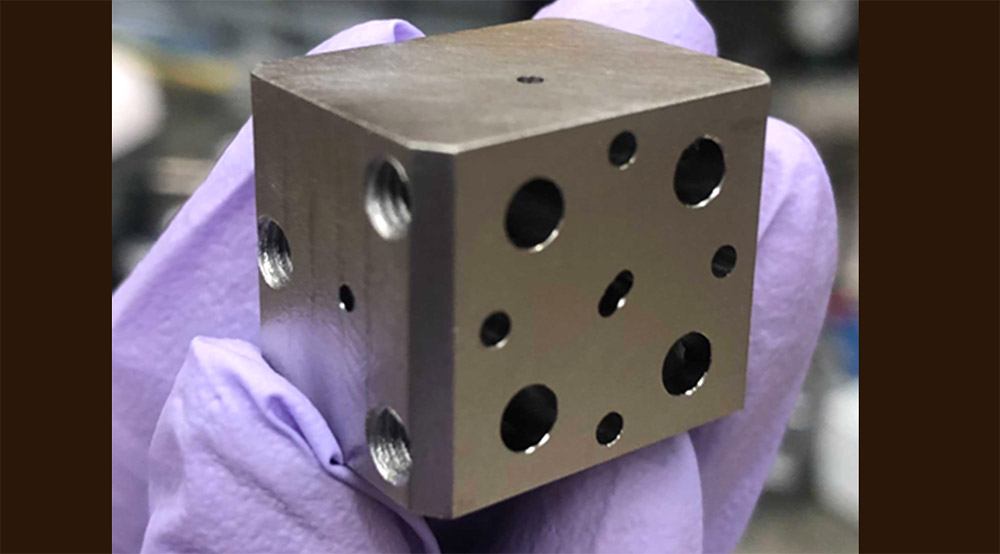Component for the quantum internet: Physicists have developed a quantum information translator – a kind of quantum modem. This converts the microwaves typical of quantum computers into easily transportable photons of light. At the heart of this quantum translator are very cold rubidium atoms, which act as photon transducers, keeping quantum entanglement intact. This opens up new possibilities for remotely connecting quantum computers, the team reports in the journal Nature.
Quantum computers and quantum communication are important technologies of the future. However, the two are only compatible with each other to a limited extent: most quantum computers, like those from IBM and Google, use superconducting transmitting qubits that store and transmit their information in microwave photons. However, optical photons are required to transmit quantum information over long distances, for example via optical fiber, satellite or laser-free air link.
Why is translation necessary?
The reason for this: Although radiation at microwave frequencies is ubiquitous for public communications such as mobile communications, WLAN or GPS, it is not suitable for transmitting fragile and entangled quantum information. “At microwave frequencies, the information encoded in the photon is lost in thermal noise,” explains lead author Aishwarya Kumar of the University of Chicago. Thus optical frequencies are better suited for efficient transmission of quantum information because they are less susceptible to interference.
But this means: you need a translator that converts microwave photons emitted by a quantum computer into phototransmission photons while preserving their entanglement – a quantum modem. However, previous “translators” in the form of nanostructured crystals or resonators had low efficiency and limited bandwidth.
Niobium block as a transformer chamber
Kumar and her team have now developed a new kind of quantum modem. This consists of a chamber at the junction of three waveguides etched into a block of superconducting niobium. Using a laser trap, very cold rubidium atoms are transported through one of these lanes to the center of the quantum converter and pinned there. These atoms have energy gaps between their different excited states which exactly correspond to the energy of microwave photons on the one hand and photons of light on the other.
“In their ground state, these atoms are strongly coupled to light photons, and when excited by Rydberg states, they are coupled to microwave photons,” the physicists explain. The second waveguide in the niobium block acts as an optical cavity: it carries semi-transparent mirrors at either end that reflect microwaves and millimeter-scale photons of light, enhancing their interaction with the rubidium atoms. Light photons loaded with quantum information exit back through this waveguide. The millimeter wave radiates through channel three, where the chamber acts as a resonator – resonance effects occur.
From microwave to optical and back
Quantum translation ultimately occurs through the transition of rubidium atoms between different energy states and their interaction with the chamber environment. The atoms are first brought into the Rydberg state by a UV laser and each can now absorb a microwave photon at wavelengths in the millimeter range using quantum information. Entanglement is transferred to the atom, so that quantum information is preserved.
When the UV laser is turned off and the blue laser is turned on, the rubidium atom reverts to a lower energy state, emitting a photon of light in the process. This now carries the entanglement of the original microwave photon and thus the quantum information. In preliminary tests, this quantum conversion achieved a conversion efficiency of 58% with a thermal noise of 0.6 photons, Kumar and colleagues report. The reverse translation – from photons of light to microwave photons – was also possible in the chamber of the superconducting resonator.
An interface between a quantum computer and the quantum internet
According to the researchers, their quantum translator creates a new way to efficiently convert signals from quantum computer qubits into transmittable optical quantum signals. This technology is therefore suitable as an interface between static quantum computers and quantum communication, and thus could become an important component of the quantum internet in the future.
“The exciting thing about this platform is its ability to deploy entanglement efficiently,” says Kumar. Entanglement is central to almost all important quantum technologies — from computers and quantum simulations to quantum measurements and atomic clocks. Our results ultimately opened up a whole new field of quantum research using hybrid millimeter waves and photons of light. (Nature, 2023; doi: 10.1038/s41586-023-05740-2)
Source: Chicago Quantum Exchange

“Total coffee aficionado. Travel buff. Music ninja. Bacon nerd. Beeraholic.”







More Stories
Researchers detect extremely high-energy gamma rays
Anxiety disorders in old age increase the risk of dementia
Researchers are particularly fascinated by these exoplanets.